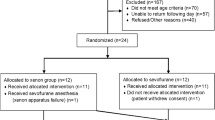Abstract
Objective. Artefact detection is an essential feature of automatic EEG monitoring systems used in anaesthesia. Clinical experience indicates that Narcotrend monitoring (MonitorTechnik, Bad Bramstedt, Germany, version 4.0) excludes more EEG epochs because of artefacts than bispectral index monitoring (BIS, Aspect Medical Systems, Newton, MA, version XP). Whether this increased exclusion of epochs is justified has not been investigated yet. Methods. Eighteen adult patients undergoing radical prostatectomy were investigated. Induction of anaesthesia was performed with a fentanyl bolus and a propofol infusion. Additionally, following intubation patients received 15 ml bupivacaine 0.5% epidurally. After a waiting period of 45 min depth of anaesthesia was varied two times by increasing and decreasing propofol concentrations. Narcotrend index, BIS values and calculated propofol effect site concentrations were automatically recorded at intervals of 5 s. We tested the hypothesis whether exclusion of artefacts detected by the Narcotrend monitor would possibly improve the prediction probability of the BIS monitor, justifying the necessity of artefact suppression. Results. Simulated propofol effect site concentrations ranged from 2 μ g/ml to 6 μ g/ml. The Narcotrend monitor excluded a significantly higher percentage of epochs because of artefact detection (12.6 ± 1.0%) than the BIS monitor (0.4 ± 0.1%). The performance of BIS as an indicator of predicted propofol effect site concentrations did not differ when including (P K = 0.86 ± 0.05) or excluding (P K = 0.85 ± 0.04) the data pairs where Narcotrend monitor but not BIS monitor indicated an artefact. Artefacts were evenly distributed over the investigated range of propofol effect site concentrations. Conclusion. Exclusion of data pairs that were detected as artefacts by Narcotrend but not by BIS did not change the performance of bispectral index as an indicator of propofol effect site concentration.
Similar content being viewed by others
References
Kreuer S, Biedler A, Larsen R, Schoth S, Altmann S, Wilhelm W. The Narcotrend – a new EEG monitor designed to measure the depth of anaesthesia. A comparison with bispectral index monitoring during propofol-remifentanil-anaesthesia. Anaesthesist 2001; 50: 921–925.
Loomis AL, Harvey EN, Hobart CA. Cerebral states during sleep as studied by human brain potentials. J Exp Psychol 1937; 21: 127–144.
Kugler J. Elektroenzephalographie in Klinik und Praxis. Thieme Stuttgart New York, 1981.
Kreuer S, Wilhelm W, Grundmann U, Larsen R, Bruhn J. Narcotrend index versus bispectral index as EEG measures of anaesthetic drug effect during propofol anesthesia. Anesth Analg 2004; 98: 692–697.
Marsh B, White M, Morton N, Kenny GN. Pharmacokinetic model driven infusion of propofol in children. Br J Anaesth 1991; 67: 41–48.
Dyck JB, Varvel J, Hung O, Shafer SL. The pharmacodynamics of propofol vs. age. Can J Anaesth 1991; 38: A-106.
Smith WD, Dutton RC, Smith NT. Measuring the performance of anesthetic depth indicators. Anesthesiology 1996; 84: 38–51.
Johnson LC. Autonomic measures as electrophysiological techniques for evaluation of the central nervous system. Handbook of Electroencephalography and Clinical Neurophysiology, Vol. 8B, Elselvier, 1973: pp. 23–42.
Bruhn J, Bouillon TW, Hoeft A, Shafer SL. Artefact robustness, inter- and intra-individual baseline stability, and rational EEG parameter selection. Anesthesiology 2002; 96: 54–59.
Barlow JS. Artefact processing in EEG data processing. In: Lopes Da Silva, FH, Storm van Leeuwen, W, Remond, A, ed. Clinical Applications of Computer Analysis of EEG and Other Neurophysiological Signal, Amsterdam. Elsevier, 1986: pp. 15–62.
Eckert O. Automatic artefact detection in intraoperative EEG monitoring. Biomed Tech 1998; 43: 236–242.
Kreuer S, Biedler A, Larsen R, Altmann S, Wilhelm W. Narcotrend monitoring allows faster emergence and a reduction of drug consumption in propofol-remifentanil anesthesia. Anesthesiology 2003; 99: 34–41.
Author information
Authors and Affiliations
Corresponding author
Additional information
Ellerkmann RK, Kreuer S, Wilhelm W, Wenningmann I, Roepcke H, Hoeft A, Bruhn J. The correlation of the bispectral index with propofol effect site concentrations is not altered by epochs indicated as artefactloaded by narcotrend
Rights and permissions
About this article
Cite this article
Ellerkmann, R.K., Kreuer, S., Wilhelm, W. et al. The Correlation of the Bispectral Index with Propofol Effect Site Concentrations is not Altered by Epochs Indicated as Artefact-Loaded by Narcotrend. J Clin Monit Comput 18, 283–287 (2004). https://doi.org/10.1007/s10877-005-2700-8
Received:
Accepted:
Issue Date:
DOI: https://doi.org/10.1007/s10877-005-2700-8




